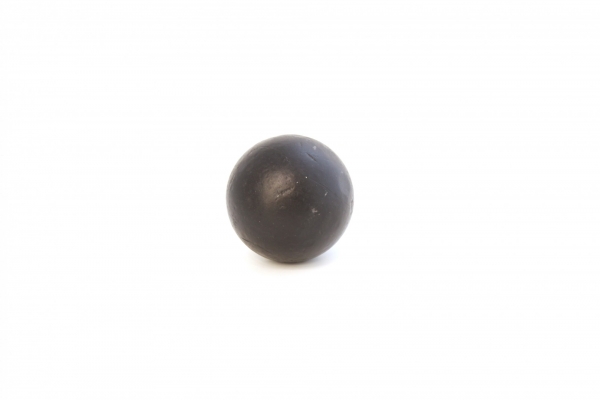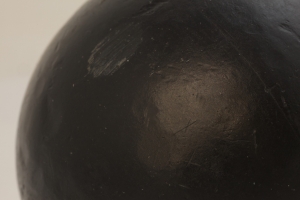
We think this is a replica lead cannonball, coated in tar to stop it from oxidizing. Because lead is such a stable metal, the vast majority of cannonballs that were fired or lost during historical military action have survived, little altered, almost exactly where they fell. Lead shot therefore provides the most significant and tangible physical record of military action. What is thought to be the oldest cannonball in the archaeological record has been found at a medieval battle site in Northampton, and is thought to have been used in the War of the Roses (1460).
‘Shot towers’, like the 190ft building that used to dominate the skyline in Edmonton (north London) until the late 20th century, are used to make small lead projectiles for muskets and pistols. Ingots of lead are combined with antimony (or arsenic in the past) to make it flow more smoothly and then melted at between 370 and 420 degrees Celsius. This liquid metal is then dropped over 150ft, travelling at 130mph in about 3 seconds, through sieves that determine the size of the shot, and into a pool of water to prevent them being deformed on impact. Apocraphally, this method is reported to have been invented by a plumber from Bristol who found spheres of lead roofing that melted during a church fire and landed in a puddle. Cannonballs are too large to be produced by this method - you would need a very tall tower! - so this object would either have been cast, or made by swaging lead sheet into a mould. This method leaves an un-aerodynamic seam where the two parts of the mould meet, so cannonballs are often tumbled in a barrel to make them more smooth.
In 1852, German physicist Gustav Magnus was trying to figure out why spinning cannonballs sometimes curved in unpredictable ways. What he discovered was that when any object is spinning, there is a force produced in a perpendicular direction to the spin axis: so when the object is spinning clockwise (or with topspin), the force is down, and if it is anticlockwise then the force is up. This knowledge gained from observing cannonballs is still being used today to understand topspin in tennis, and how to pitch the perfect curveball in baseball.
Sample ID: 1387
Particularities
- Selections
- Categories
- Metal
- Curiosities
- Relationships
- Accidental | Aerodynamics | Ball | Dense | Forces | Historical | Lead | Lift | Military | Physics | Projectile | Replica | Soft | Sphere | Spherical | Spin | Stable
Add materials you find interesting to your own selections.
Use the  button to select a material and get started.
button to select a material and get started.



